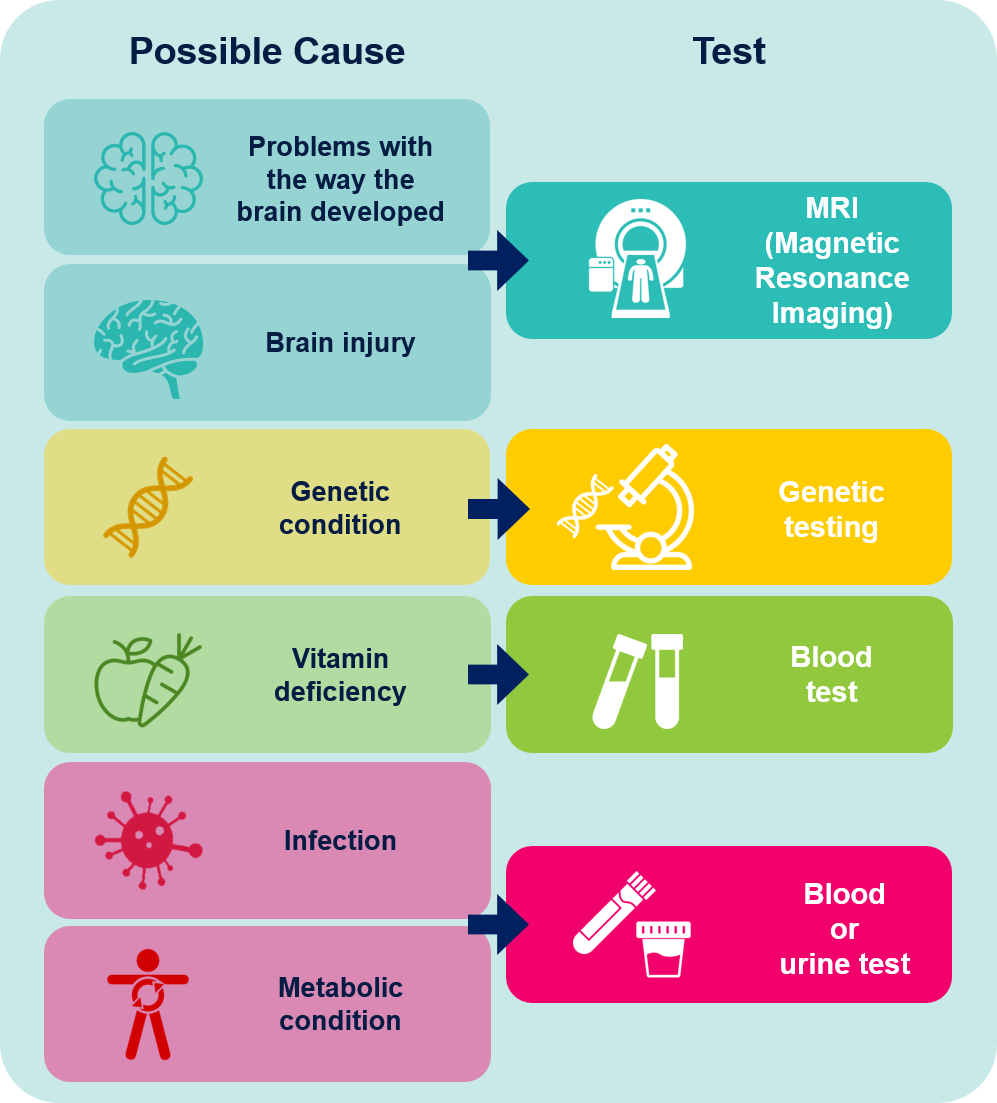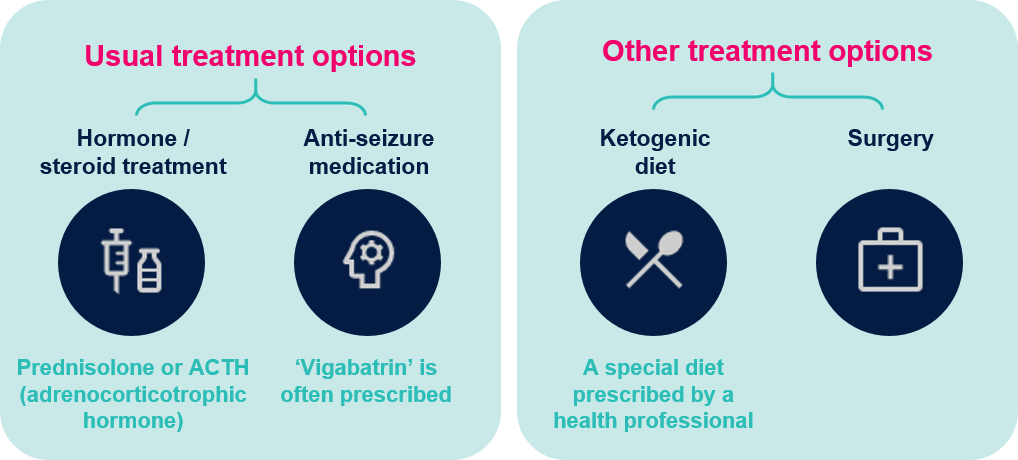What are infantile spasms?
- Infantile spasms are a rare type of seizure (fit) that usually start in children under 1 year of age.1 2
- The spasms most often start between the ages of 3 and 7 months.3 4 5
What does an infantile spasm look like?
- Infantile spasms typically occur in clusters.6
- The spasms are usually quite short (1–3 seconds), followed by a pause, and then another spasm.
- These seizures can be quite subtle, or hard to spot.
- Most children with infantile spasms will have several clusters of spasms each day.
- The spasms may be confused with other problems in babies, such as colic or reflux.
- The difference is that children with infantile spasms will repeat the same movement for 10–20 minutes. This cluster will then be seen again later in the day.
- Infantile spasms often occur soon after the child has woken up.
- Infants may become irritable or cry while they are having a cluster of spasms.
During an infantile spasm, a child may:
- Bend forward and pull their arms and/or legs into their body
- Fling their arms and legs outwards
- Drop their head
- Roll their eyes
Vidoes showing typical infantile spasms can be found on the UK infantile Spasms Trust Website
How are infantile spasms diagnosed?
Doctors usually diagnose infantile spasms by:7
- Observing spasms in the child – either in person or from a video. Videos taken on a phone by parents or carers may be helpful.
- Doing an EEG (electroencephalogram). This is used to look for disorganised brainwave patterns that show frequent seizure activity. The most common pattern is called hypsarrhythmia. More information about EEGs can be found here.
- The combination of infantile spasms, hypsarrhythmia and developmental regression is sometimes called West Syndrome.
- More information about West Syndrome is available at the Epilepsy Action UK website.
- West Syndrome is a subgroup of the wider infantile spasm condition which is now known as Infantile Spasm Syndrome.
What causes infantile spasms?
- Infantile spasms have many possible causes.8 9
- Several different tests can be done to find out the cause. Doctors decide which tests are most appropriate for each child.
- In some children, the spasms are related to something that was noticed and diagnosed previously. For example, a lack of oxygen at birth.
- Doctors will usually ask about the child’s medical history and do an examination.
- In many children, a brain scan (MRI), blood and urine tests (and sometimes spinal fluid from a spinal tap), and/or initial genetic tests will find a cause for the infantile spasms.
- At the moment, a cause is not found in 20–30% of children (2 or 3 out of every 10).
- Further genetic testing is considered for children who still do not have a diagnosis. More information about genetic testing can be found here. Research is ongoing to try and get better genetic tests and find more answers for more families.
- Some possible causes are shown in the below diagram, along with the tests that can be done to identify them.
Possible causes of infantile spasms:

How are infantile spasms managed?
- The below diagram illustrates some of the treatment options for infantile spasms.
- Vigabatrin is particularly helpful in children with a particular genetic condition called Tuberous Sclerosis. Infantile spasms are often the first symptom of Tuberous Sclerosis.

How do infantile spasms affect children?
- Once infantile spasms start, children may slow or stop or go backwards in their physical and learning development. This means they may stop focussing on their caregiver, ignore sounds or words, or stop smiling. Some children lose skills they have already developed. This is called developmental regression.
- The regression seen when the spasms start is related to the abnormal brainwave patterns. Doctors call this an epileptic encephalopathy. Early treatment can help stop this regression.
- Some children will go on to have normal development. However, other children will continue to have delayed development, especially if their development was not normal before the seizures started. If a child has continued developmental delay as well as abnormal brainwave activity, this is called developmental and epileptic encephalopathy (DEE).
Short and long-term effects will be different for each individual child. It depends on many things, including:10 11 12
- The underlying cause of the spasms
- How old the child was when the spasms started
- Whether the child had any problems with their development before the spasms started
- The time between the seizures starting and when the child received treatment.
An important minority of children have their infantile spasms controlled and go on to have normal development. This is more likely to happen if:
- The infantile spasms responded to the initial medication
- The child does not have another severe brain disorder
- Development was normal before the spasms started.
Many children with Infantile Spasm Syndrome will have their spasms fully controlled in the short term. However, often children will go on to have other types of seizures in later childhood. Depending on the cause of the spasms, children may also have:
- Developmental and/or intellectual disability
- Behavioural and/or psychiatric problems
- Autism spectrum disorder
- Cerebral palsy.
Children who have had a diagnosis of Infantile Spasm Syndrome, particularly those with known ongoing seizures, are at an increased risk of sudden unexpected death in epilepsy (SUDEP). More information about SUDEP and what to do if you are concerned can be found here.
Is there any current research into infantile spasms?
Research is happening in Australia and overseas to try to better understand:
- How best to diagnose the underlying causes of infantile spasms
- Which treatments are best for which types of infantile spasms
- How best to predict the long-term health effects after infantile spasms.
For example, an Australia-wide program of studies looking at how conditions develop over time (natural history studies) starts soon. This program will include a broad range of childhood onset epilepsies.
You can find out more about clinical trials for infantile spasms, or particular genetic causes of infantile spasms, by registering on the Australian Clinical Trials network, as shown on this website.
------------
Content on this page was generated via the GeneCompass project. The following article provides more information about the project:
- Robertson EG, Kelada L, Best S, Goranitis, I, Grainger N, Le Marne F, Pierce K, Nevin, SM, Macintosh R, Beavis E, Sachdev R, Bye A, Palmer EE. (2022). Acceptability and feasibility of an online information linker service for caregivers who have a child with genetic epilepsy: a mixed-method pilot study protocol. BMJ Open, 12:e063249. https://doi.org/10.1136/bmjopen-2022-063249
- 1 Epileptic or infantile spasms. Epilepsy Foundation (US): https://www.epilepsy.com/learn/types-seizures/epileptic-or-infantile-spasms
- 2 About infantile spasms. UK Infantile Spasms Trust: https://ukinfantilespasmstrust.org/about-infantile-spasms/
- 3 Infantile Spasms Syndrome. Paediatric Epilepsy Network NSW (PENNSW): https://pennsw.schn.health.nsw.gov.au/clinicians/syndromes/infantile-spasms-syndrome
- 4 Infantile Spasms. The Royal Children’s Hospital Melbourne: https://www.rch.org.au/clinicalguide/guideline_index/Infantile_Spasms/
- 5 What are infantile spasms? Children’s Hospital of Pittsburgh: https://www.chp.edu/our-services/brain/neurology/epilepsy/types/syndromes/infantile-spasms
- 6 Infantile spasms. Child Neurology Foundation: https://www.childneurologyfoundation.org/disorder/infantile-spasms/
- 7 Wheless (2012): https://pubmed.ncbi.nlm.nih.gov/22830456/
- 8 All About Infantile Spasms. UK Infantile Spasms Trust: https://ukinfantilespasmstrust.org/ukistwp/wp-content/uploads/2018/11/UKIST-Information-Guide.pdf
- 9 Infantile Spasms. Nemour’s Kids Health: https://kidshealth.org/NemoursXML/en/parents/infantile-spasms.html
- 10 West syndrome (infantile spasms). Epilepsy Action (UK): https://www.epilepsy.org.uk/info/syndromes/west-syndrome-infantile-spasms
- 11 Infantile Spasms. HealthyChildren.org: https://www.healthychildren.org/English/health-issues/conditions/seizures/Pages/Infantile-Spasms-What-Parents-Need-to-Know.aspx
- 12 West Syndrome. National Organization for Rare Disorders (NORD): https://rarediseases.org/rare-diseases/west-syndrome/